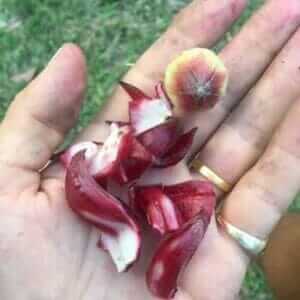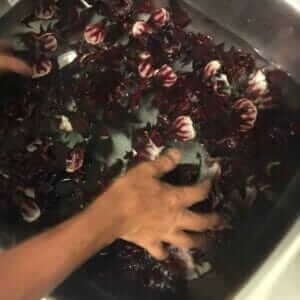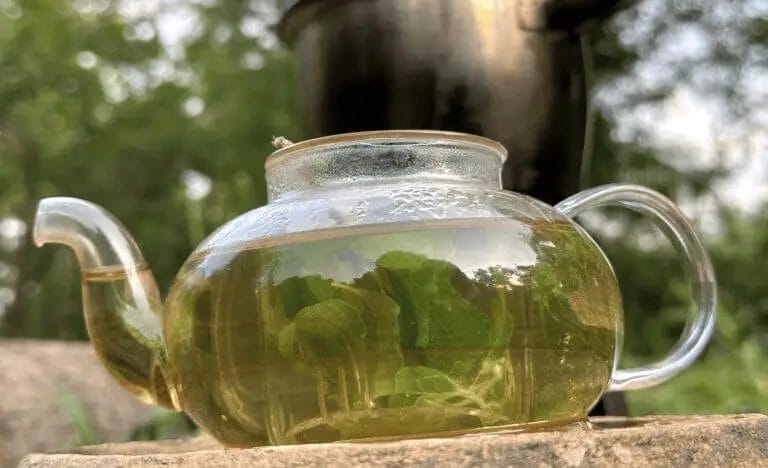Sproutingfam.com is supported by its readers. If you purchase through a link on my site, I may earn a commission. Learn more
Roselle Juice Recipe Made From Fresh Calyx (Hibiscus Tea)
This Roselle juice recipe is made using fresh Roselle plant flowers (calyx).
It can be made both with fresh flowers or from dried calyces as well.
Unless you’re making Thai tea or a Chai, tea is generally extremely simple to make. Rosella tea is no different.

What is the difference between Roselle Tea and Hibiscus Tea?

Originally when creating this recipe I though that Roselle plant’s proper name was Hibiscus. But I found out that this “hibiscus tea” is more accurately called “Roselle tea“.
Roselle tea or Roselle juice is not Hibiscus Tea. It is made from flowers in the Hibiscus genus.
When looking up more information about Hibiscus Tea, I found that a different type of Hibiscus tea comes from Hibiscus flowers that look like this:

Our Roselle Juice Recipe here does not use flowers that look like this picture with the hummingbird and the red Hibiscus flowers. The reason for my confusion is that Hibiscus is a genus of flowering plants with hundreds of different species.
The differences are summed up nicely here by Garden Lovers Club:
The confusion in common names and scientific classification often causes issues with large plant groups like hibiscus. In this case, all true roselle plants—which might be known locally as rosella, red sorrel, Florida cranberry, or Jamaica sorrel—are hibiscus plants, but not all hibiscus plants are roselle.
– Garden Lovers Club
Roselle plant is just one of the hundreds of species variations.
When fully bloomed, the Roselle variety of the Hibiscus flower (this recipe) looks like this:

Roselle juice comes from the calyxes harvested before they get to this bloom point. And some are harvested without a Hibiscus flower ever blooming.
So that clears the Hibiscus vs Roselle tea confusion.
Next is the proper naming of the Roselle tea itself.
It has many names depending on what country you’re in.
The Many Popular Names Of Roselle Juice
The Roselle plant has several different names. It grows along the same latitude across the world, native to tropical and subtropical regions, and naturally each country has its own name for it.
This recipe’s particular species of Hibiscus (Roselle Flower) comes from the hibiscus sabdariffa species. The hibiscus sabdariffa species is said to be native to West Africa (but this is not certain). When the sabdiriffa species (this recipe!) is infused in hot water, the result is known as “carcade.”
- In Mexico it’s known as Agua De Jamaica or Jugo De Jamaica (J sounds like an H).
- In other places like the UK it’s known as Sorrel Juice.

As long as the flower looks like these images, then we’re talking about the same plant for this recipe, the Roselle plant.
These same flowers above fully budded and harvested in the pot:

6 Names Used For Roselle Juice Around The World.
Roselle juice or tea seem to be the most common in the U.S.A.
- Hibiscus tea
- Rosella (Australia)
- Flor De Jamica – “Hamaica” (Flower in Latin countries)
- Agua De Jamaica – “Hamaica” (the Roselle Juice in Latin countries)
- Sorrel plant (in U.K. based Asian or Caribbean stores)
- Guddahal Flower & Tea (India)
Roselle Tea Benefits
Other than the fact that it’s so easy to make, Roselle is a unique plant with the most notable health benefit being for high blood pressure. Because of this, it’s considered a medicinal plant. And it has a unique taste that blends well with many other fruits. So your creation options are endless.
I prefer straight Roselle juice with no added sugar at all, just a bit of salt while boiling. But usually a sweetener at the least is added, like honey, sugar or stevia extract. Other fruits can work great too, like oranges and limes.
What Is Roselle Juice Good For? Lots…
There’s a 2015 study in the Journal of Hypertension that showed Roselle plant may reduce blood pressure in the amounts of 7.5/3.5 units, systolic/diastolic (source).
Hibiscus tea benefits from the Roselle plant provide far more than the reduction of blood pressure as well. It is a super healthy herbal tea, and while there are no official studies that back up many of its health benefits, from researching this plant’s beneficial qualities, I believe it’s a great addition to any home remedies list. Here’s a quick list of some Hibiscus tea benefits I found online from Healthline and a few other articles (source):
- Full of antioxidants
- May lower blood fat levels
- Liver health (this is one of my favorites!)
- May promote weight loss
- Potential cancer preventative
- Bacteria fighting qualities
This article on Herbpathy boasts a long list of very great health benefits potentially received from Roselle juice/Hibiscus tea. Here are some of them:
- Baldness (when applied topically)
- Urinary tract infection (UTI)
- Menstrual disorders
- Diarrhea
- Kidney disease
- Dandruff (topically)
- Cough
- High cholesterol
- Wounds (topically)
- Depression: Roselle has antidepressant properties that help relax nervous tension and provide daily stress and anxiety relief.
- Liver diseases
- Candidiasis
To learn more about how Roselle juice can help with these things, that Herbpathy article is very informative.
Before we get into the Roselle juice recipe, here’s Milli, our one-eyed dog that runs (*update: ran) with the big boys and is the scrappiest one of the pack. She’s an amazing dog that just showed up one day with an open-wounded, slashed face that had her eye-ball drooping out due to this what I think was a machete slash.

How To Make Roselle Juice From Fresh Roselle Calyces (RC)
- Boil fresh or dried flowers for 15 minutes, and you’re done.
- That’s it, recipe finished.
If that’s not the easiest recipe we’ll ever publish on our blog, then I don’t know what will be.
Even though that’s all it takes, let’s now break this Roselle juice recipe down further, starting from the tall Roselle plants in the garden, to the pitcher on my kitchen table. If you have fresh Roselle flowers, you have the added benefit of being able to make a delicious jam with them. Visit our Roselle Jam recipe.
The proper term for the Roselle flower petals are “calyces.” The calyx and the epicalyx are you boil to make the tea.

When removing the calyxes and epicalyces from the flower, you’re basically just removing the seed pod.
Removing The Seed Pods (Highly Preferred, But Not 100% Mandatory)
I am not sure what will happen if you do boil the seed pod outside because I’ve never tried it, I’m sure the lectins added do something, but I’m not sure. One thing to watch out for are the Roselle plant seedpod’s minuscule thorns.
Update Re: seed pods – We got a comment down below that mentions boiling the seed pods. Jill commented:
Please stop calling the red fleshy part the flower. The flower bloomed and dropped off before the seedpods formed and the calyxes enlarged. Some recipes I’ve read say to boil the seedpods in water to get the pectin from them, then use the water to boil the calyxes for jam. It worked for me.
You’ll want to wear gloves while removing the seedpod. The seedpods have tiny hair-like spikes that hurt a lot when they stick into your fingers. And they’re hard to get out. I haven’t found any specific Roselle plant de-seeders, but you can easily make them.
The video below shows a man removing Roselle seed pods with a hollow metal tube like this one.
A hardware store should have a right sized metal tube that you could turn into a Roselle plant seedpod remover.
Alternatively, you can just remove the calyces off the Roselle plant and leave the seeds intact on the plant. We just did it and it lets the seeds fully mature on the stem as they would normally.

Step-By-Step Roselle Juice Recipe Directions
Let’s finally see how this Roselle Juice/Hibiscus tea is made from the fresh Roselle flowers.
While many online Roselle tea recipes say to steep these calyces in boiling water for like 5 minutes, we find the tea is deeper red and with a stronger taste (not too strong) at around 10 to 15 minutes’ time.
Step 1. De-Seed the Roselle flowers (remove pods)
Harvest the flowers then peel the petals (calyces) off.

You use the calyx part of the flower. Not the seed pod.
Once all Roselle flowers are de-seed podded, it’s time to clean them off with regular drinking water and get some water boiling in a pot.
Step 2. Wash flower then boil
We did a triple wash before starting the boil.

Once the flower is in the boiling water, add a pinch of salt. This helps balance out the natural bitterness.
Step 3. Add sweetener of choice (or don’t)
If you want you can add a sweetener of your towards the end of the boil.
After 10 minutes or so of boiling the Roselle calyces, you end up with a wonderful deep red tea.
Now you have yourself some delicious Roselle Juice!

And that’s all there is to this easy herbal tea recipe!
Making Hibiscus Tea From Dried Flowers?
If you don’t have fresh flowers, but instead have the dried Hibiscus (Roselle) flower, then you can still make a wonderful, healthy, deep red colored tea, but you can’t make the jam. The jam requires the fresh flowers from what I know.
It’s the same process with dried Hibiscus. Generally you want to use 1 or 2 tablespoons per cup of water. I prefer using 2 per cup.
With the dried Roselle flowers, you’ll want to use around 2 tablespoons of dried Roselle calyces per cup of water.
Print The Roselle Juice Recipe
Looking to print the Roselle Tea recipe? Here’s the printable recipe PDF:
Roselle Tea Recipe (From Fresh Calyx)
Equipment
- stove
- steel pot
Ingredients
- 1 cup Roselle calyces, de-seeded
- 1 tsp Sea salt
- 1 tbsp Brown sugar
Instructions
Video
Notes
Roselle Juice Variations
Looking for a perfect addition to your brunch with or without alcohol?
Here are some other variations of Roselle Tea from the Food Network.
Thanks for coming to our blog and viewing our roselle recipe. We appreciate your interest.
We’ll work on putting up more recipes with herbs, flowers and plants that we grow onto the blog.
Next Recipe: An Easy Thai Cuisine Thai Basil Stir Fry or Pad Krapow.















How much water do you use for boiling the calyx
Hey Ricardo, apologies for the late reply. Been crazy busy lately. How much water? Because we make the jam and juice from the same batch, I put maybe 1 gallon of water or 1.5. Not sure I never measure. I just fill up that big pot halfway. It really just depends on how concentrated you want it. If you put too much water you can just boil it down more.
Thanks so much! I have been looking extensively for a recipe using the fresh calyxes! I am going to be making this in my garden based science class. We grew a lot of it and it has made tons of flowers.
Nice! Hope it goes well! I’m sure it will. That sounds like a great class. Is that a university class?
RECIPES for several tea
10 cups of water to 4 ounces of the calyxes.
Another recipe:
Add about 1 inch piece of fresh ginger, and boil with (same as above) 15 min, turn off (This is where to add sugar or sweetener of your choice), and let set to cool.
Then in your container add 1 squeezed lemon, OR (1 squeezed lime.)
Add the cooled tea on top of the citrus , shake and enjoy.
For it to make a lemon zinger, also add the lemon zest of 1 lemon to pot when you are boiling ginger, red Roselle leaves. Then after it cools pour over fresh squeezed lemon. (This is delicious, and refreshing).
Thank you Karen! This does sound very delicious and refreshing! We make the ginger tea like that but have never added the lemon zest to the pot. We have endless limes from the tree, but all lemons are imported around here, so I will give this a try with our limes. Thanks for the comment
So here’s something interesting: I can get roselles from my local farmer at the market, and they gave a tea recipe that did not involve removing the seeds. When I read your blog, I assumed the farmer must have deseeded first, but no. I’ve made delicious tea from them before, and the seeds didn’t seem to hurt the end result. What are the advantages of removing the seeds? Thank you so much!!
Hey Sherrie, late reply eh!? Just saw this. For me, I don’t use sugar and so I like the flavor of the pure flowers boiled. I have not tried the other way. I’d imagine it’s a slightly different flavor? Maybe even better? I should try. However, we do make jam out of it. I know seeds contain lectins. Pressure cooking removes lectins, but does boiling remove them too? That’s the only thing I’d have to look into. The jam we make every time at the same time and it is perfect without the seeds. I think for the jam, I wouldn’t leave the seeds in. But for the tea, that would be a time saver! I will have to try this. Thanks for letting us know!
Please stop calling the red fleshy part the flower. The flower bloomed and dropped off before the seedpods formed and the calyxes enlarged. Some recipes I’ve read say to boil the seedpods in water to get the pectin from them, then use the water to boil the caylyxes for jam. It worked for me.
Hi Jill, Yesterday we harvested this year’s batch. Some did have flowers bloom and fall off last week and prior, however most seemed to have not. Regardless I will have to use the proper terminology and say calyx every time. Thanks for the correction. And thanks for the info about boiling seedpods for pectins. That’s good to know for those who do want the pectins.
Thank you for this great update
Thank you
Thanks for the instructions! I had a question – can these be steeped instead of boiled? Is it dangerous if it’s not boiled?
Hi Nancy, thanks for the comment and question. I will try a steep soon. To make a quick tea it may be perfectly fine to just steep, but I’m thinking it wouldn’t be as strong of a flavor, especially if you’re making the “juice”. It seems these really need some hot water to extract their flavors, but it’s worth a try. I will try. I highly doubt it’s dangerous if not boiled. I am not sure, and haven’t looked into it, but I would think it’s perfectly safe.
Hi Nancy, its not dangerous. You can actually eat it as is including the seed pod right from the garden!
Hi John, I just read your article. I am from Jamaica where “sorrel” is an absolute necessity for Christmas. But, we do drink it year round. However, we never actively boil the sorrel . . . it is not necessary, and that may be the reason that you have some bitter taste to your drink. Whether fresh or dried, cold water is added to the sorrel along with crushed ginger, it is heated only until it reaches the boiling stage and then the sorrel/water/ginger mixture is removed from the heat and allowed to steep overnight. It is then strained and sweetened, with a little sweet red wine (or in the Caribbean, a little rum) added. This lasts for a very long time in the refrigerator. I think actively boiling the sorrel for some length of time may actually destroy some of the healthy compounds in the sorrel.
This is amazing. I concur the boil likely destroys some of the nutrients. It’s something I’d like to know for sure though. This is very great to know thank you a ton for sharing. I have a feeling I’m going to start doing it your way. Maybe we’ll do an alcoholic version as well as normal one. Will update you afterwards. Thanks again.
Hi, John. I forgot to add to my previous comment that when I wish to have a hot cup of sorrel juice, I just pour some from the refrigerated juice and heat in the microwave. I grew 24 sorrel plants this year in Houston and I have so far frozen 12 gallon bags of the calices, with a lot more waiting for harvest. I have kept the calices frozen for two months with no freezer damage whatsoever, and there is no difference in quality when it is used to make juice. We also store half-gallon freezer-safe plastic bottles of juice in the freezer so we continue to have sorrel juice for several months into the following year.
My farm recipe said 1/2 liter (2 cups, 2 tbls) water to 1/2 lb petals. That doesn’t seem like enough water. That’s why I found this recipe and you don’t say how much water to use. That is not helpful at all. Thanks!
Haha well that’s no good. We’re horrible with measurements because Ling does everything by eyeing it out. We’ve been getting better, but need to update older recipes. I hope you found the information you need by now, but I’ll update this post soon with more precise ingredient measurements.